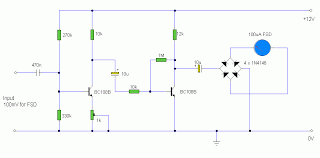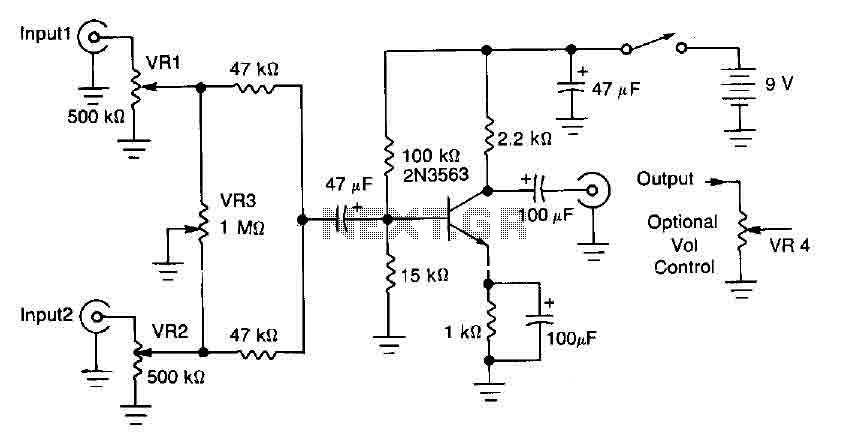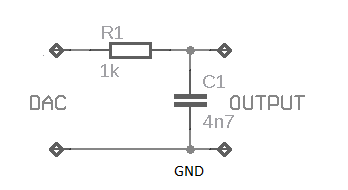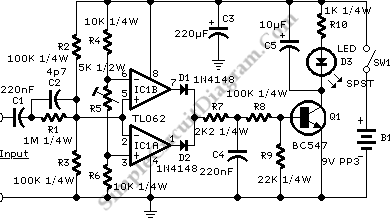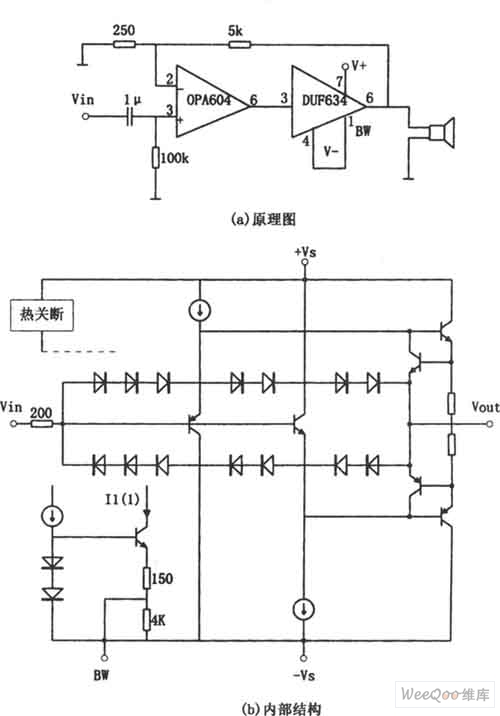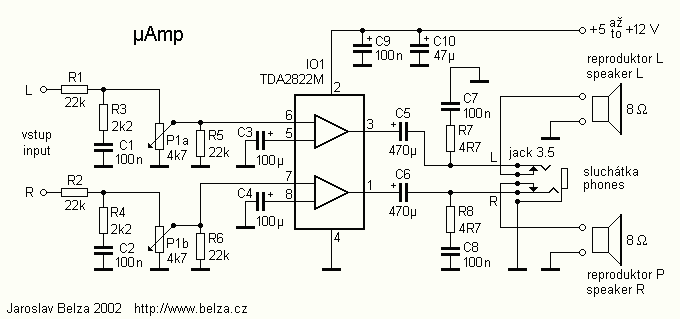
PCM1794A audio DAC
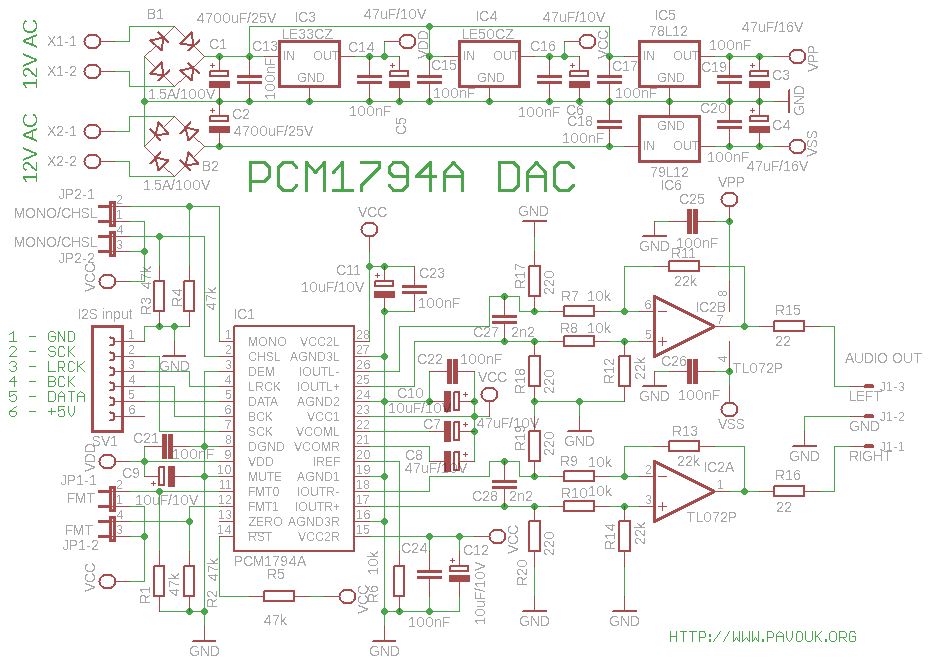
A transformer with two separate 12V secondary windings is required for the power supply. If the transformer does not have a third separate winding, the supply input of the S/PDIF decoder must be connected in parallel to the positive winding to avoid a short circuit. The voltage is rectified by bridge rectifiers B1 and B2, followed by filtering and decoupling capacitors, which feed low-dropout regulators IC3 and IC4 that supply the analog and digital parts of the DAC. IC5 and IC6 regulate +12V and -12V for the operational amplifier. All supply inputs of the DAC are properly decoupled with capacitors. The DAC PCM1794A operates with data from a standard I2S bus, utilizing a system clock signal (SCK) for proper function and oversampling. The input data format, output type, and characteristics of the digital filter are selected using jumpers. The circuit includes an internal reset with an external pull-up resistor R5. The output is current differential, and resistors R17 to R20 are used for conversion to a voltage output; these should be high-quality carbon resistors. Theoretically, a symmetrical output can be taken to a high-impedance input of a preamplifier after these resistors. Capacitors C27 and C28 limit high frequencies outside the audible range. A low-noise operational amplifier TL072 is used to obtain a single-ended output with an average value around zero, providing a gain of about two. The design is inspired by an original circuit, as there is limited expertise in operational amplifiers. The original circuit also employed operational amplifiers for current-to-voltage conversion. Only high-quality resistors were used for simplicity. Quiet outputs show zero voltage, indicating that coupling capacitors may not be necessary. One output measured approximately 12mV, while the other measured 2.6mV, suggesting potential improvements through resistor value selection. Components are arranged from smaller to larger, starting with IC1, following the layout of the S/PDIF decoder. SMD resistors and capacitors were placed next, followed by wire connections and connectors. The printed circuit board (PCB) is single-sided with two wire connections, facilitating easy fabrication in amateur conditions. Ground wires are arranged to separate the digital and analog sections. Decoupling capacitors are positioned close to the DAC. The prototype PCB shown in photos differs slightly, with an additional pull-up resistor R5 on the reset signal, which is not specified in the datasheet. SMD resistors and capacitors of size 0805 were replaced with 1206 for easier mounting. Wire connections were successfully reduced from five to two. The circuit is configured with four jumpers, which, when not installed, are pulled down to zero with resistors. The audio format settings are detailed in a table, with I2S or right-justified 24-bit format being the most common. When connecting the board to the S/PDIF decoder, identical data format and system clock frequency settings must be applied. For playback of 192kHz samples, the system clock must be set to a maximum of 384 x fs. Further information can be found in the datasheet. The PCM1794A audio DAC boasts excellent performance and sound quality. Oscilloscope traces appear satisfactory, although high-frequency traces at 20kHz with a sample frequency of 44.1kHz show some smoothed connections instead of distinct "stairs," which is likely typical in oversampling DACs. The objective is to achieve a DAC without oversampling to ensure high fidelity playback. Initial circuit functionality issues arose due to a missing pull-up resistor on the RESET signal, possibly due to insufficient reset function descriptions or incomplete circuit schematics in the datasheet. For improved performance, it may be beneficial to replace the TL072 operational amplifier with a higher-quality alternative. The output amplifier can also be bypassed entirely, allowing for symmetrical output.
A comprehensive electronic schematic for the described circuit would include the following components and connections:
1. **Transformer**: A dual 12V secondary winding transformer, ensuring isolation and proper voltage levels for the DAC and decoder.
2. **Rectification**: Two bridge rectifiers (B1 and B2) to convert AC voltage from the transformer to DC voltage, followed by smoothing capacitors to reduce ripple.
3. **Voltage Regulation**: Low-dropout regulators (IC3 and IC4) to provide stable voltage levels for the analog and digital sections of the DAC.
4. **Operational Amplifiers**: IC5 and IC6 for generating +12V and -12V supplies for the operational amplifier circuitry.
5. **DAC (PCM1794A)**: Central component for digital-to-analog conversion, fed by an I2S bus with proper clocking from the SCK signal.
6. **Resistors**: High-quality carbon resistors (R17 to R20) for current-to-voltage conversion, arranged to ensure minimal signal degradation.
7. **Decoupling Capacitors**: Strategically placed close to the DAC to filter out high-frequency noise and stabilize voltage levels.
8. **Jumpers**: Configurable connections allowing for selection of audio format and system clock settings, ensuring compatibility with various data formats.
9. **PCB Design**: A single-sided layout with careful routing to minimize interference between digital and analog sections, featuring ground planes for stability.
10. **Reset Circuit**: Incorporating a pull-up resistor (R5) to ensure reliable operation of the reset function.
This schematic would provide a clear representation of the circuit's functionality and layout, ensuring optimal performance and ease of assembly for users.For power supply is needed transformer with two individual secondary 12V windings. If you want to supply from transformer S/PDIF decoder and transformer doesn`t have third separated winding, we must connect supply input of decoder parallel to winding for positive branch otherwise there will be short circuit. Voltage is rectified by B1 and B2 bridg es and goes through filter and decoupling capacitors to low-drop regulators IC3 and IC4 which feeds analog and digital part of DAC. IC5 and IC6 regulates voltage +12V and -12V for operational amplifier. All supply inputs of DAC are properly decoupled with capacitors. DAC PCM1794A works with data from standard I2S bus. In addition to it use signal SCK - System clock, which needs for proper function and oversampling. Input data format, output type and characterics of digital filter is selected with jumpers. Circuit includes internal reset with external pull-up resistor R5. Output is current differential. For conversion to voltage output I use resistors R17 to R20. They should be high quality carbon resistors. Behind these resistors we can theoretically take out symmetrical output to high impedance input of preamplifier.
C27 and C28 are used for limit of high frequencies out of audible sound. For getting of single-ended output with average value at zero I used low-noise operating amplifier TL072. Gain is about two. I inspired by original circuit because I am not specialist for operating amplifiers. In original circuit are used operating amplifiers for conversion of current to voltage output too. I used only resistors which are better and simpler. In quiet outputs have zero voltage, that theoretically we don`t need coupling capacitors. On one output was voltage about 12mV and on another 2. 6mV. It can be better by selecting value of resistors. Parts are placed from smaller to bigger. I begin with IC1. Method of his placing is same like on S/PDIF decoder. Next I continued with SMD resistors and capacitors. Next I placed wire connections and components from a top side of board and last connectors. Printed circuit board is single sided with two wire connections, that it can be easily made in amateur conditions.
Ground wires are drawed with accent to separating of digital and analog part. Decoupling capacitors are placed closely to DAC. PCB of prototype on photos is a little different in these smallness: In schematics is additional pull-up resistor R5 on a reset signal. In datasheet is not discoverable that it must be used. SMD resistors and capacitors with size 0805 was replaced with 1206 size for easier mounting. I was succesful in reducing of wire connections from five to two. Circuit is configured with 4 jumpers. When they are not installed, that they are pull-downed to zero with resistors. Setting of audio format is described next in the table. Most frequently I meet with I2S or right-justified 24bit format. If we connect board to our S/PDIF decoder, we must on them set identical data format and frequency of system clock.
If we want to play 192kHz samples, we must set system clock maximally to 384 x fs. More informations are in a datasheet. Audio DAC with PCM1794A has excellent parameters and sounds great. Traces on a scope looks very good too, but with high frequency 20kHz with sample frequency 44. 1kHz we can see in a trace instead of "stairs" some smoothed connection with multiple traces. It is probably normal in a DAC with oversampling. My goal is to have DAC without oversampling which should guarantee high fidelity of playing. Circuit doesn`t worked immediately for me. Reason was missing pull-up resistor on RESET signal. It could have insufficient description of reset function and incomplete schematics of circuit in a datasheet or my misunderstanding. For getting better parameters it is possible to try change operational amplifier TL072 with something better.
We can completely bypass output amplifier and use symmetrical 🔗 External reference
A comprehensive electronic schematic for the described circuit would include the following components and connections:
1. **Transformer**: A dual 12V secondary winding transformer, ensuring isolation and proper voltage levels for the DAC and decoder.
2. **Rectification**: Two bridge rectifiers (B1 and B2) to convert AC voltage from the transformer to DC voltage, followed by smoothing capacitors to reduce ripple.
3. **Voltage Regulation**: Low-dropout regulators (IC3 and IC4) to provide stable voltage levels for the analog and digital sections of the DAC.
4. **Operational Amplifiers**: IC5 and IC6 for generating +12V and -12V supplies for the operational amplifier circuitry.
5. **DAC (PCM1794A)**: Central component for digital-to-analog conversion, fed by an I2S bus with proper clocking from the SCK signal.
6. **Resistors**: High-quality carbon resistors (R17 to R20) for current-to-voltage conversion, arranged to ensure minimal signal degradation.
7. **Decoupling Capacitors**: Strategically placed close to the DAC to filter out high-frequency noise and stabilize voltage levels.
8. **Jumpers**: Configurable connections allowing for selection of audio format and system clock settings, ensuring compatibility with various data formats.
9. **PCB Design**: A single-sided layout with careful routing to minimize interference between digital and analog sections, featuring ground planes for stability.
10. **Reset Circuit**: Incorporating a pull-up resistor (R5) to ensure reliable operation of the reset function.
This schematic would provide a clear representation of the circuit's functionality and layout, ensuring optimal performance and ease of assembly for users.For power supply is needed transformer with two individual secondary 12V windings. If you want to supply from transformer S/PDIF decoder and transformer doesn`t have third separated winding, we must connect supply input of decoder parallel to winding for positive branch otherwise there will be short circuit. Voltage is rectified by B1 and B2 bridg es and goes through filter and decoupling capacitors to low-drop regulators IC3 and IC4 which feeds analog and digital part of DAC. IC5 and IC6 regulates voltage +12V and -12V for operational amplifier. All supply inputs of DAC are properly decoupled with capacitors. DAC PCM1794A works with data from standard I2S bus. In addition to it use signal SCK - System clock, which needs for proper function and oversampling. Input data format, output type and characterics of digital filter is selected with jumpers. Circuit includes internal reset with external pull-up resistor R5. Output is current differential. For conversion to voltage output I use resistors R17 to R20. They should be high quality carbon resistors. Behind these resistors we can theoretically take out symmetrical output to high impedance input of preamplifier.
C27 and C28 are used for limit of high frequencies out of audible sound. For getting of single-ended output with average value at zero I used low-noise operating amplifier TL072. Gain is about two. I inspired by original circuit because I am not specialist for operating amplifiers. In original circuit are used operating amplifiers for conversion of current to voltage output too. I used only resistors which are better and simpler. In quiet outputs have zero voltage, that theoretically we don`t need coupling capacitors. On one output was voltage about 12mV and on another 2. 6mV. It can be better by selecting value of resistors. Parts are placed from smaller to bigger. I begin with IC1. Method of his placing is same like on S/PDIF decoder. Next I continued with SMD resistors and capacitors. Next I placed wire connections and components from a top side of board and last connectors. Printed circuit board is single sided with two wire connections, that it can be easily made in amateur conditions.
Ground wires are drawed with accent to separating of digital and analog part. Decoupling capacitors are placed closely to DAC. PCB of prototype on photos is a little different in these smallness: In schematics is additional pull-up resistor R5 on a reset signal. In datasheet is not discoverable that it must be used. SMD resistors and capacitors with size 0805 was replaced with 1206 size for easier mounting. I was succesful in reducing of wire connections from five to two. Circuit is configured with 4 jumpers. When they are not installed, that they are pull-downed to zero with resistors. Setting of audio format is described next in the table. Most frequently I meet with I2S or right-justified 24bit format. If we connect board to our S/PDIF decoder, we must on them set identical data format and frequency of system clock.
If we want to play 192kHz samples, we must set system clock maximally to 384 x fs. More informations are in a datasheet. Audio DAC with PCM1794A has excellent parameters and sounds great. Traces on a scope looks very good too, but with high frequency 20kHz with sample frequency 44. 1kHz we can see in a trace instead of "stairs" some smoothed connection with multiple traces. It is probably normal in a DAC with oversampling. My goal is to have DAC without oversampling which should guarantee high fidelity of playing. Circuit doesn`t worked immediately for me. Reason was missing pull-up resistor on RESET signal. It could have insufficient description of reset function and incomplete schematics of circuit in a datasheet or my misunderstanding. For getting better parameters it is possible to try change operational amplifier TL072 with something better.
We can completely bypass output amplifier and use symmetrical 🔗 External reference
